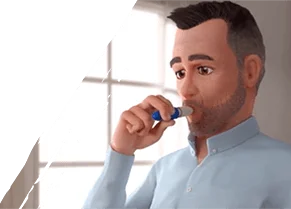

Actor portrayal.
Nurse Educators are on call to help you gain confidence using your INBRIJA
You may contact them at1-833-INBRIJA
8 AM to 8 PM ET Monday through Friday
Actor portrayal.
It may take several tries for you to become familiar with inhaling INBRIJA. It's important not to be discouraged based on your first few tries.
Nurse Educators are available to support you with additional training by phone or video and to answer questions about how to use the inhaler.
Explore these resources designed to offer support while fighting returning symptoms with INBRIJA.




Storing, cleaning, and disposing of your INBRIJA inhaler
Storage and Cleaning of Your INBRIJA Inhaler
Store your inhaler and capsules at room temperature (68 °F to 77 °F
[20 °C to 25 °C]), in a dry place.
That means no freezing or refrigerating.
Keep the capsules inside their foil (blister) packages until just before you are ready to use them. Do not preload (store capsules inside) the inhaler for a future dose.
Keep INBRIJA out of the reach of children.
It is normal for some powder to remain in or on the inhaler. You can clean the inside and outside of the mouthpiece using a circular motion with a dry cotton swab.
Make sure you don't get the inhaler wet. You may also use a dry tissue to wipe the outside of the mouthpiece as needed.
When all the capsules in a carton are gone, throw the inhaler in the trash. Each carton of capsules includes an inhaler, so you'll get a new inhaler with each new medication delivery.
Storing, cleaning, and disposing of your INBRIJA inhaler
Storage and Cleaning of Your INBRIJA Inhaler
Store your inhaler and capsules at room temperature (68 °F to 77 °F
[20 °C to 25 °C]), in a dry place.
That means no freezing or refrigerating.
Keep the capsules inside their foil (blister) packages until just before you are ready to use them. Do not preload (store capsules inside) the inhaler for a future dose.
As for all medicines, keep INBRIJA out of the reach of children.
Keep INBRIJA out of the reach of children.
It is normal for some powder to remain in or on the inhaler. You can clean the inside and outside of the mouthpiece using a circular motion with a dry cotton swab.
Make sure you don't get the inhaler wet. You may also use a dry tissue to wipe the outside of the mouthpiece as needed.
When all the capsules in a carton are gone, throw the inhaler in the trash. Each carton of capsules includes an inhaler, so you'll get a new inhaler with each new medication delivery.
Connect With Advocacy Groups
Connect With Advocacy Groups
- American Parkinson's Disease Association
- The Michael J. Fox Foundation for Parkinson's Research
- Caregiver Action Network
- Davis Phinney Foundation for Parkinson's
- Parkinson's Foundation
FL: 200 SE 1st Street, Ste 800, Miami, FL 33131
NY: 1359 Broadway, Ste 1509, New York, NY 10018
1-800-4PD-INFO (473-4636)Email: contact@parkinson.org - Parkinson & Movement Disorder Alliance

Tips to Manage the Return of Your PD Symptoms
Pace yourself during the day
You can help keep fatigue at bay by saving your strength and taking frequent breaks. Making sure you have some downtime here and there will help you relax and recharge.
Know your rhythms
Are you a morning person? A night owl? Somewhere in between? Schedule errands and activities to make the best use of your daily rhythms.
Get creative with exercise
Improve motor function and engage your mind at the same time with skill-based exercises. Try walking a course with a specific time goal. Make sure to talk to your doctor and care team before starting a new exercise routine.
Make shopping simple*
Conserve your strength for when you need it by making shopping as easy for yourself as possible. Here are some ideas:
- Try shopping online and automated deliveries for products you routinely buy
- Bring a family member or friend along for company when you go shopping—having company can make shopping less of a chore and more of a fun, social activity
- Streamline your trips. When you go to the store, try to map out your trips so you can visit several stores located close to one another
By following these tips, you can save your energy and enjoy quality time with the people you care about.
Make eating out more enjoyable*
Heading out to break bread with family and friends? Set yourself up to succeed at having a great time by:
- Avoiding crowds—go before or after the usual meal rush
- Planning your order ahead of time—that way, you can focus on enjoying yourself at the table
Remember to take your INBRIJA with you
Easy to carry in your purse, pocket, or bag, the inhaler and blister capsules can go with you almost anywhere. Make sure to keep INBRIJA dry and at room temperature.
*Tell your healthcare provider if you experience unusual uncontrollable urges such as binge eating and shopping.
INBRIJA® (levodopa inhalation powder) IMPORTANT CONSUMER SAFETY INFORMATION
What is INBRIJA?
INBRIJA is an inhaled levodopa prescription medicine used to treat the return of Parkinson’s symptoms (known as OFF episodes) in people with Parkinson’s disease who are treated with carbidopa/levodopa medicines. INBRIJA does not replace regular carbidopa/levodopa medicine. It is not known if INBRIJA is safe or effective in children.
Do not use INBRIJA if you: take or have taken a nonselective monoamine oxidase inhibitor such as phenelzine or tranylcypromine within the last 2 weeks.
Before using INBRIJA, tell your healthcare provider about your medical conditions, including if you:
- have asthma, chronic obstructive pulmonary disease (COPD), or any chronic lung disease
- have daytime sleepiness, sleep disorders, sleepiness/drowsiness without warning, or use medicine that increases sleepiness, including antidepressants or antipsychotics
- have dizziness, nausea, sweating, or fainting when standing up
- have abnormal movement (dyskinesia)
- have mental health problems such as hallucinations or psychosis
- have uncontrollable urges like gambling, sexual urges, spending money, or binge eating
- have glaucoma
- are pregnant or plan to become pregnant. It is unknown if INBRIJA can harm your unborn baby.
- are breastfeeding or plan to breastfeed. Levodopa can pass into breastmilk and it is unknown if it can harm the baby.
Tell your healthcare provider about all of the medicines you take, including prescription and over-the-counter medicines, vitamins and herbal supplements.
Using INBRIJA and certain other medicines may affect each other and cause serious side effects. Especially tell your healthcare provider if you take:
- MAO-B inhibitors
- dopamine (D2) antagonists (including phenothiazines, butyrophenones, risperidone, metoclopramide)
- isoniazid
- iron salts or multivitamins that contain iron salts
How should I use INBRIJA?
INBRIJA is for oral inhalation use only. Do not swallow or open INBRIJA capsules. Only use INBRIJA capsules with the INBRIJA inhaler. Do not use the INBRIJA inhaler to take any other medicine.
Do not orally inhale more than 1 dose (2 capsules) for any OFF period. Do not take more than 5 doses (10 capsules) in a day.
What should I avoid while taking INBRIJA?
Do not drive, operate machinery, or do other activities until you know how INBRIJA affects you. Sleepiness and falling asleep suddenly can happen as late as a year after treatment is started.
What are the possible Side Effects of INBRIJA?
INBRIJA can cause serious side effects including:
- falling asleep during normal daily activities with or without warning. If you become drowsy, do not drive or do activities where you need to be alert for your safety or the safety of others. Chances of falling asleep during normal activities increases if you take medicine that cause drowsiness.
- withdrawal-emergent hyperpyrexia and confusion (fever, stiff muscles, or changes in breathing and heartbeat) if you suddenly stop using INBRIJA or carbidopa/levodopa, or suddenly lower your dose of carbidopa/levodopa.
- low blood pressure when standing up (that may or may not happen with dizziness, fainting, nausea, and sweating). Get up slowly after sitting/lying down.
- hallucinations and other psychosis - INBRIJA may cause or worsen seeing/hearing/believing things that are not real; confusion, disorientation, or disorganized thinking; trouble sleeping; dreaming a lot; being overly suspicious or feeling people want to harm you; acting aggressive; and feeling agitated/restless.
- unusual uncontrollable urges such as gambling, binge eating, shopping, and sexual urges has occurred in some people using medicine like INBRIJA.
- uncontrolled, sudden body movements (dyskinesia) may be caused or worsened by INBRIJA. INBRIJA may need to be stopped or other Parkinson's medicines may need to be changed.
- bronchospasm - people with asthma, COPD, or other lung diseases may wheeze or have difficulty breathing after inhaling INBRIJA. If this occurs, stop taking INBRIJA and seek immediate medical attention.
- increased eye pressure in patients with glaucoma. Your healthcare provider should monitor this.
- changes in certain lab values including liver tests.
The most common side effects of INBRIJA are cough, upper respiratory tract infection, nausea, and change in the color of saliva or spit. Another side effect of INBRIJA is sensation of choking right after use.
These are not all the possible side effects of INBRIJA
- Call your doctor for medical advice about side effects.
- You are encouraged to report negative side effects of prescription drugs to the FDA. Visit www.fda.gov/medwatch or call 1-800-FDA-1088.
The risk information provided here is not comprehensive. To learn more:
- Talk to your health care provider or pharmacist.
- Visit www.inbrija.com to obtain the Full Prescribing Information, Patient Information, and Instructions for Use.
- Call 1-800-367-5109
INBRIJA® Indication
Treats OFF periods in adults taking carbidopa/levodopa (CD/LD). INBRIJA doesn't replace CD/LD.
Important Safety Information
Don't use if you have taken a nonselective monoamine oxidase inhibitor (eg, phenelzine, tranylcypromine) within the last 2 weeks.
SEE MORE 


